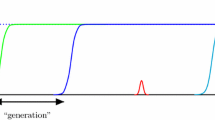Abstract
In our previous report [Aita, T., Morinaga, S., Hosimi, Y., 2004. Thermodynamical interpretation of evolutionary dynamics on a fitness landscape in an evolution reactor I. Bull. Math. Biol. 66, 1371–1403], an analogy between thermodynamics and adaptive walks on a Mt. Fuji-type fitness landscape in an artificial selection system was presented. Introducing the ‘free fitness’ as the sum of a fitness term and an entropy term and ‘evolutionary force’ as the gradient of free fitness on a fitness coordinate, we demonstrated that the adaptive walk (=evolution) is driven by the evolutionary force in the direction in which free fitness increases. In this report, we examine the effect of various modifications of the original model on the properties of the adaptive walk. The modifications were as follows: first, mutation distance d was distributed obeying binomial distribution; second, the selection process obeyed the natural selection protocol; third, ruggedness was introduced to the landscape according to the NK model; fourth, a noise was included in the fitness measurement. The effect of each modification was described in the same theoretical framework as the original model by introducing ‘effective’ quantities such as the effective mutation distance or the effective screening size.
Similar content being viewed by others
References
Aita, T., Morinaga, S., Husimi, Y., 2004. Thermodynamical interpretation of evolutionary dynamics on a fitness landscape in an evolution reactor I. Bull. Math. Biol. 66, 1371–1403.
Amitrano, C., Peliti, L., Saber, M., 1989. Population dynamics in a spin-glass model of chemical evolution. J. Mol. Evol. 29, 513–525.
Arias, A., Lazaro, E., Escarmis, C., Domingo, E., 2001. Molecular intermediates of fitness gain of an RNA virus: characterization of a mutant spectrum by biological and molecular cloning. J. Gen. Virol. 82, 1049–1060.
Eigen, M., McCaskill, J.S., Schuster, P., 1989. The molecular quasispecies. Adv. Chem. Phys. 75, 149–263.
Einstein, A., 1905. On the movement of small particles suspended in stationary liquids required by the molecularkinetic theory of heat. Ann. Phys. 17, 549–560 (in German).
Escarmis, C., Davila, M., Domingo, E., 1999. Multiple molecular pathways for fitness recovery of an RNA virus debilitated by operation of Muller’s ratchet. J. Mol. Biol. 285, 495–505.
Garske, T., Grimm, U., 2004. A maximum principle for the mutation-selection equilibrium of nucleotide sequences. Bull. Math. Biol. 66, 397–421.
Husimi, Y., 1989. Selection and evolution of bacteriophages in cellstat. Adv. Biophys. 25, 1–43.
Iwasa, Y., 1988. Free fitness that always increases in evolution. J. Theor. Biol. 135, 265–281.
Kauffman, S.A., 1993. The Origin of Order. Oxford University Press, Oxford.
Keefe, A.D., Szostak, J.W., 2001. Functional proteins from a random-sequence library. Nature 410, 715–718.
Lazaro, E., Escarmis, C., Domingo, E., Manrubia, S.C., 2002. Modeling viral genome fitness evolution associated with serial bottleneck events: evidence of stationary states of fitness. J. Virol. 76, 8675–8681.
Levitan, B., Kauffman, S., 1995. Adaptive walks with noisy fitness measurements. Mol. Divers. 1, 53–68.
Maekawa, K., Mori, N., Tamaki, H., Kita, H., Nishikawa, Y., 1997. A genetic solution for the travelling salesman problem by means of a thermodynamical selection rule. Trans. Soc. Instrum. Control. Eng. 33, 939–946.
Mandecki, W., Chen, Y.C., Grihalde, N., 1995. A mathematical model for biopanning (affinity selection) using peptide libraries on filamentous phage. J. Theor. Biol. 176, 523–530.
Muller, H.J., 1964. The relation of recombination to mutational advance. Mutat. Res. 1, 2–9.
Novella, I.S., Duarte, E.A., Elena, S.F., Moya, A., Domingo, E., Holland, J.J., 1995. Exponential increases of RNA virus fitness during large population transmissions. Proc. Natl Acad. Sci. 92, 5841–5844.
Prügel-Bennett, A., 1997. Modelling evolving populations. J. Theor. Biol. 185, 81–95.
Rechenberg, I., 1984. The evolution strategy: a mathematical model of Darwinian evolution. In: Frehland, E. (Ed.), Synergetics: From Microscopic to Macroscopic Order. Springer Series in Synergetics, vol. 22. pp. 122–132.
Stellinger, F.H., Weber, T.A., 1984. Packing structures and transitions in liquids and solids. Science 225, 983–989.
Sun, F., Galas, D., Waterman, M.S., 1996. A mathematical analysis of in vitro molecular selection-amplification. J. Mol. Biol. 258, 650–660.
Weinberger, E.D., 2002. A theory of pragmatic information and its application to the quasi-species model of biological evolution. Biosystems 66, 105–119.
Woodcock, G., Higgs, P.G., 1996. Population evolution on a multiplicative single-peak fitness landscape. J. Theor. Biol. 179, 61–73.
Yamauchi, A., Nakashima, T., Tokuriki, N., Hosokawa, M., Nogami, H., Arioka, S., Urabe, I., Yomo, T., 2002. Evolvability of random polypeptides through functional selection within a small library. Protein Eng. 15, 619–626.
Yang, Y., Wang, H., Ouyang, Q., 2003. Dynamics of DNA in vitro evolution with Mnt-repressor: simulations and analysis. Phys. Rev. E 68, 031903.
Author information
Authors and Affiliations
Corresponding author
Rights and permissions
About this article
Cite this article
Aita, T., Morinaga, S. & Husimi, Y. Thermodynamical interpretation of evolutionary dynamics on a fitness landscape in an evolution reactor, II. Bull. Math. Biol. 67, 613–635 (2005). https://doi.org/10.1016/j.bulm.2004.09.004
Received:
Accepted:
Issue Date:
DOI: https://doi.org/10.1016/j.bulm.2004.09.004




